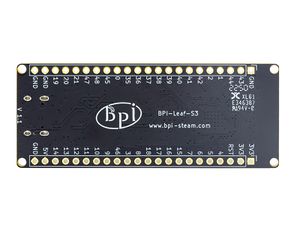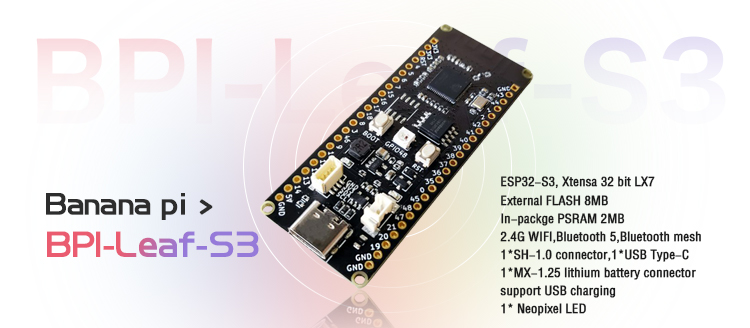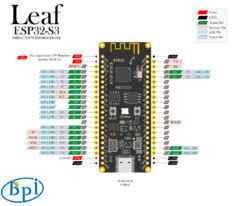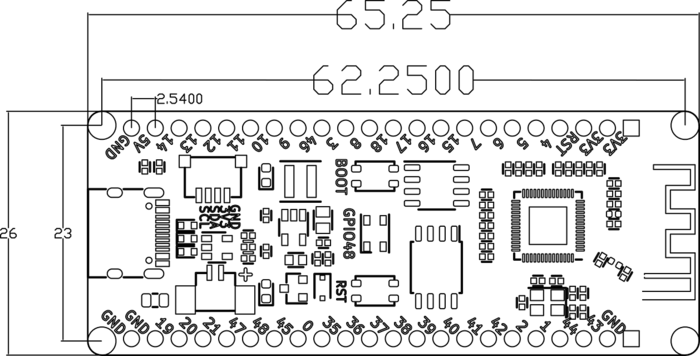BPI-Leaf-S3
Contents
[hide]Introduction


The Banana Pi Leaf series are low-power microcontrollers designed for the Internet of Things.
The Leaf-S3's onboard ESP32-S3 chip is powered by an Xtensa® 32-bit LX7 dual-core processor with a main frequency of up to 240 MHz.
It supports 2.4 GHz Wi-Fi and Bluetooth® LE dual-mode wireless communication, the peripheral is compatible with low-power hardware design, and the power consumption is only 10uA in deep sleep mode.
The main controller supports two power supply modes: USB and external 3.7V lithium battery, which can realize the function of automatic power switching under dual power supply, and supports USB charging mode. Small size, convenient interface, easy to use, and can be directly applied to low-power IoT projects.
In terms of programming, Leaf-S3 motherboard supports ESP-IDF, Arduino, micropython and other methods for programming and development.
All IO pins corresponding to the chip are marked on the Leaf-S3 motherboard, which lowers the threshold for use.
Key Features
- ESP32-S3,Xtensa® 32 bit LX7
- External PSRAM , FLASH
- Ultra-low power 10uA
- 2.4G WIFI ,Bluetooth 5 ,Bluetooth mesh
- GPIO , ADC , TOUCH , PWM , I2C , SPI , RMT , I2S , UART , LCD,CAMERA ,USB , JTAG
- 1* 4pin I2C connector
- 1 * USB Type-C
- 1 * 2pin battery connector,support charging
- 1 * Neopixel LED
Hardware
Hardware sketch map
Hardware Spec
| BPI-Leaf-S3 Spec | |
|---|---|
| SoC | ESP32-S3,Xtensa® dual-core 32-bit LX7 microprocessor |
| Clock Frequency | 240MHz MAX |
| Ambient Temperature | -40℃~+85℃ |
| Internal ROM | 384 KB |
| Internal SRAM | 320 KB |
| External FLASH ROM | 8MB |
| External PSRAM | 8MB |
| WIFI | IEEE 802.11 b/g/n ,2.4Ghz,150Mbps |
| Bluetooth | Bluetooth 5 ,Bluetooth mesh |
| GPIO | BPI-Leaf-S3 has led out 36 available gpios |
| ADC | 2 × 12-bit SAR ADCs, up to 20 channels |
| Touch Sensor | 14 |
| SPI | 4 |
| I2C | 2 |
| I2S | 2 |
| LCD | 1 × LCD interface (8-bit ~16-bit parallel RGB, I8080 and MOTO6800) |
| CAMERA | 1 × DVP 8-bit ~16-bit camera interface |
| UART | 3 |
| PWM | 8 channels 14 bits |
| MCPWM | 2 |
| USB | 1 × full-speed USB OTG,female Type-C socket |
| USB Serial/JTAG controller | 1,CDC-ACM ,JTAG |
| Temperature sensor | 1,range of –20 °C to 110 °C |
| SD/MMC | 1 × SDIO host controller with 2 slots,SD 3.0,SD 3.01,SDIO 3.0,CE-ATA 1.1,MMC 4.41,eMMC 4.5,eMMC 4.51 |
| TWAI® controller | 1 ,compatible with ISO 11898-1 (CAN Specification 2.0) |
| General DMA controller (GDMA) | 5 transmit channels and 5 receive channels |
| RMT | 4 TX channels,4RX channels.Eight channels share a 384 x 32-bit RAM |
| Pulse Count Controller | 4 independent pulse counters (units).Each unit consists of two independent channels |
| Timers | 4 × 54-bit general-purpose timers.1 × 52-bit system timer.3 × watchdog timers |
| External crystal oscillator | 40Mhz |
| RTC and LowPower Management | Power Management Unit (PMU) + Ultra-Low-Power Coprocessor(ULP) |
| Deep-sleep consumption current | 10uA |
| Operating Voltage | 3.3V |
| Input Voltage | 3.3V~5.5V |
| Maximum discharge current | 2A@3.3V LDO |
| USB charge | Support |
| Maximum charging current | 500mA |
| Neopixel LED | 1 |
Hardware Dimensions
| BPI-Leaf-S3 Dimensions | |
|---|---|
| Pin spacing | 2.54mm |
| Mounting hole spacing | 23mm/ 62.25mm |
| Mounting hole size | bore 2mm/outside 3mm |
| Motherboard size | 26 × 65.25(mm)/1.02 x 2.57(inches) |
| board thickness | 1.2mm |
The pin spacing is breadboard compatible for easy application debugging.
Peripheral Pin Configurations
| BPI-Leaf-S3 GPIO Pin define | ||
|---|---|---|
| Peripheral Interface | Signal | Pin |
| ADC | ADC1_CH0~9 | GPIO 1~10 |
| ADC2_CH0~9 | GPIO 11~20 | |
| Touch sensor | TOUCH1~14 | GPIO 1~14 |
| JTAG | MTCK | GPIO 39 |
| MTDO | GPIO 40 | |
| MTDI | GPIO 41 | |
| MTMS | GPIO 42 | |
| UART | The pins are assigned by default, and can be redefined to any GPIO | |
| U0RXD_in | GPIO 44 | |
| U0CTS_in | GPIO 16 | |
| U0DSR_in | any GPIO | |
| U0TXD_out | GPIO43 | |
| U0RTS_out | GPIO 15 | |
| U0DTR_out | any GPIO | |
| U1RXD_in | GPIO 18 | |
| U1CTS_in | GPIO 20 | |
| U1DSR_in | any GPIO | |
| U1TXD_out | GPIO 17 | |
| U1RTS_out | GPIO 19 | |
| U1DTR_out | any GPIO | |
| U2 | any GPIO | |
| I2C | any GPIO | |
| PWM | any GPIO | |
| I2S | any GPIO | |
| LCD | any GPIO | |
| CAMERA | any GPIO | |
| RMT | any GPIO | |
| SPI0/1 | Used for FLASH and PSRAM | |
| SPI2/3 | any GPIO | |
| Pulse counter | any GPIO | |
| USB OTG | D- | GPIO 19(on-chip PHY) |
| D+ | GPIO 20(on-chip PHY) | |
| VP | GPIO 42(external PHY) | |
| VM | GPIO 41(external PHY) | |
| RCV | GPIO21(external PHY) | |
| OEN | GPIO 40(external PHY) | |
| VPO | GPIO 39(external PHY) | |
| VMO | GPIO38(external PHY) | |
| USB Serial/JTAG | D- | GPIO 19(on-chip PHY) |
| D+ | GPIO 20(on-chip PHY) | |
| VP | GPIO 42(external PHY) | |
| VM | GPIO 41(external PHY) | |
| OEN | GPIO 40(external PHY) | |
| VPO | GPIO 39(external PHY) | |
| VMO | GPIO38(external PHY) | |
| SD/MMC | any GPIO | |
| MCPWM | any GPIO | |
| TWAI | any GPIO | |
| Neopixel LED | GPIO 48 | |
Software
MicroPython development
MicroPython is a lean and efficient implementation of the Python 3 programming language that includes a small subset of the Python standard library and is optimised to run on microcontrollers and in constrained environments.
Regardless of whether there is a programming foundation or not, MicroPython is definitely far less difficult to get started than other MCU programming languages.
Its code is easy to read, and it has rich resources accumulated over the years in the open source community.
Just like Python, it has strong vitality and application value.



